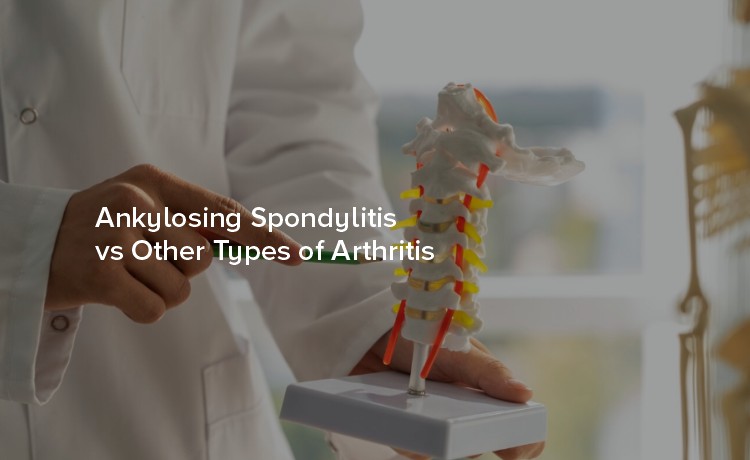
Arthritis is a term that refers to the inflammation of joints, but did you know there are over 100 distinct types of arthritis? Among them, ankylosing spondylitis (AS) stands out as a specialized form that primarily affects the spine. Understanding its differences from other types of arthritis, such as rheumatoid arthritis or osteoarthritis, is key to recognizing its symptoms, seeking appropriate treatment, and managing your condition effectively.
Ankylosing spondylitis (AS) is a type of arthritis primarily impacting the spine, though it can also affect other joints and areas of the body. It is part of a group of conditions known as axial spondyloarthritis, which also includes non-radiographic axial spondyloarthritis.
AS causes inflammation in the vertebrae (spinal joints), which can lead to chronic pain, stiffness, and over time, a fusion of the vertebrae. When this fusion occurs, it can limit flexibility and result in a “forward-stooped” posture.
Key Stats on AS
To effectively differentiate ankylosing spondylitis from other types of arthritis, recognizing its unique symptoms is critical. Common signs include:
Notably, AS's inflammatory nature can extend beyond the joints, in some cases affecting the heart, lungs, or digestive system.
Though ankylosing spondylitis falls under the broader arthritis umbrella, its characteristics vary significantly from other forms. Let's break it down further.
Osteoarthritis (OA) is the most common form of arthritis. It is a "wear-and-tear" condition that results from cartilage breakdown in joints, as opposed to the systemic inflammatory process seen in Ankylosing Spondylitis.
Key differences:
Symptoms pattern:
Rheumatoid arthritis (RA) is another inflammatory form of arthritis, but it differs in its pattern and targeted joints.
Key differences:
Joint involvement:
Progression:
Extra-articular symptoms:
Psoriatic arthritis (PsA) is another spondyloarthropathy and shares some features with AS, such as spinal involvement. However, it is often linked to the skin condition psoriasis.
Key differences:
Recognizing these differences helps in seeking the right medical attention and starting appropriate treatment as early as possible.
While there is no cure for ankylosing spondylitis, early diagnosis and treatment can significantly improve quality of life. The goal of treatment is to reduce symptoms, manage pain, and prevent the progression of the condition.
Regular exercise tailored to improve posture and flexibility is essential. Gentle stretching, yoga, or swimming can help alleviate stiffness. Working with a physical therapist familiar with Ankylosing Spondylitis is highly recommended.
Simple daily changes, such as practicing good posture, using ergonomic chairs, and ensuring quality sleep, can have a big impact. Smoking should also be avoided, as it can worsen Ankylosing Spondylitis symptoms and progression.
Although rare, surgery may be necessary for individuals with severe joint damage or deformity, particularly if hip replacement is required.
Living with Ankylosing Spondylitis can feel isolating, but there are robust patient communities and resources available. From online support forums to in-person groups, connecting with those who share similar experiences can make a big difference in managing the emotional aspect of this condition.
Every arthritis type brings its own challenges, but ankylosing spondylitis stands apart with its unique symptoms, progression, and impact on daily life. The good news? With early diagnosis and a tailored treatment plan, you can lead a fulfilling, active life.
If you or someone you know is experiencing chronic back pain, stiffness, or other symptoms discussed in this blog, consider speaking to a healthcare professional. While living with AS or any arthritis diagnosis can feel daunting, advancements in treatment provide hope and relief to millions.
Need more guidance on navigating ankylosing spondylitis symptoms or treatment? Don’t hesitate to reach out to our expert team of specialists—we’re here to help provide support and answers every step of the way.